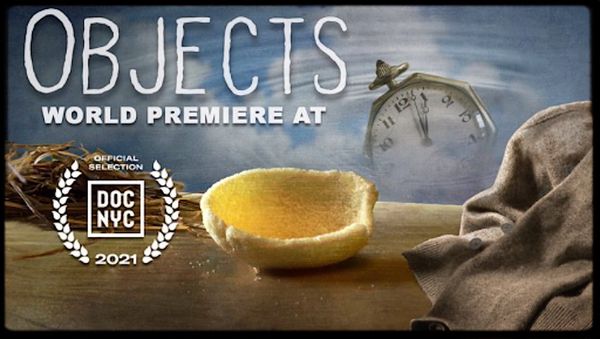Marcel Proust knew that “the past is hidden in some material object which we do not suspect.” In his novel Tomorrow In The Battle Think On Me, Javier Marías writes about the moment when we die and the transformation of our most precious belongings into trash, when “everything that had meaning and history loses it in a single moment and my belongings lie there inert, suddenly incapable of revealing their past and their origins; and someone will make a pile of them.”
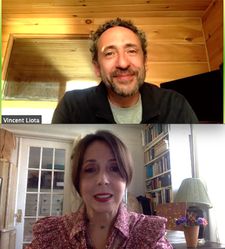 |
| Vincent Liota with Anne-Katrin Titze on the narrative mystery: “We see these things and at the beginning they’re meaningless objects and by the end they’re filled with meaning.” |
Vincent Liota in Objects explores in manifold original ways how objects hold sway over us and how sometimes their importance wildly exceeds their intrinsic value. Documentaries may hint at this, especially those about personalities in the public eye. Dr. Ruth Westheimer, for instance, in Ryan White’s documentary Ask Dr. Ruth, shows us the all important washcloth, the only object she could save from her family, before they were murdered during the Holocaust.
Tom Donahue’s Dean Martin: King Of Cool in this year’s DOC NYC festival asks about the treasured object which might constitute the entertainer’s Rosebud. We are living in a time where the Zeitgeist applauds the notion of getting rid of stuff. Marie Kondo and decluttering are applauded and one may wonder why. Is this really an anti-consumerist stance or a trick to persuade people to toss more to buy more? If these are questions you contemplate during sleepless nights, if Auld Lang Syne clutches your heart each New Year’s Eve, not only because the mysterious lyrics escape your understanding, if the doubt that there might be some sentience in inanimate objects never left you and you know that the single lonely pea you dropped wants to be cooked too - this is the film for you.
Rick Rawlins, Heidi Julavits, and Robert Krulwich are Vin’s perfectly chosen co-conspirators in the search for the elusive it factor contained in an object.
From New York, Vincent Liota joined me on Zoom for an in-depth conversation on Objects (a highlight of the 12th edition of DOC NYC) before the World Première.
Anne-Katrin Titze: Hello!
Vincent Liota: Hello, I am Vin! Nice to see you! I’m really thrilled that you’re talking to me about Objects. I was reading your posts and interviews and I just feel like you and your subjects seem way beyond my station, so I’m really just flattered and thrilled.
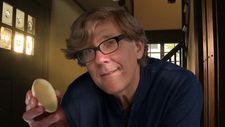 |
| Rick Rawlins with his forty-year-old sugar egg Photo: Vincent Liota |
AKT: What did you read?
VL: I looked at the Paul Auster.
AKT: That’s a good one for objects!
VL: By the way, I saw that you are a licensed wildlife rehabilitator. My daughter just started volunteering at the Wildlife Fund on Columbus Avenue.
AKT: That’s great. Well, there are interviews with people, there is wildlife, and there are objects - all equally important in some respect.
VL: Oh perfect! I looked at your Claude Lelouch on Quentin Tarantino and influencing Terrence Malick, which I had no idea about. I’m a big fan of both of them, especially Terrence Malick. And Greta Gerwig’s Little Women with Batsheva Hay.
AKT: Which I am actually wearing right now, by chance. This is a Batsheva blouse.
VL: Oh, that’s incredible.
AKT: This is not about what you read about me, let’s talk about your film.
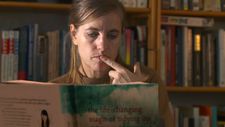 |
| Heidi Julavits ponders The Life Changing Magic Of Tidying Up, written by Marie Kondo Photo: Vincent Liota |
VL: How did you find out about Objects? What drew you to me?
AKT: As I do every year, I talk to Thom Powers about his selections for DOC NYC. I look through the program and note the films that I already know and love. And then there are the animal, vegetable, object ones where the description makes me interested. So I brought yours up to Thom and that’s how I discovered it.
VL: That’s wonderful, I’m so glad.
AKT: Yours is a subject matter that I think many people think about, but don’t talk about that much. I can’t think of any other film that treats objects the way you do. As you show, there are lots of shows about decluttering and getting rid of things, but our deep connection to inanimate objects don’t have many films out there.
VL: Yeah, I started researching and I found that to be the case. I also found that people automatically expected this to be a film about decluttering, because they’ve been so overwhelmed with that. When we talk about keeping things, it’s always a negative. The idea is that it’s not a personal style, It’s a clinical disorder. It’s bad, and even a little bit is bad. I think you have to enjoy your symptom, I suppose. The people that I interview in the film all seem like very well-adjusted people. They’re very unique, they’re all brilliant, talented at what they do. They are very much happy and their families are happy and they keep these things for so many reasons.
 |
| Robert Krulwich and his 55-year-old clump of grass Photo: Sam Cullman |
AKT: Your three subjects are perfectly chosen. They are all wonderful. When Heidi says “Everything I own sparks joy!” - what more is there to say? About the structure: at the start of your film, we see Cleopatra’s Needle, there’s the sugar egg, there’s a gray cashmere cardigan, and there’s wilted grass and we have no idea what it all means. At the end of the film - all of these objects have meaning, have history, and become something else.
VL: Thank you for noticing that. For some people it’s hard to piece those all together. It’s a narrative mystery, as Heidi would say. We see these things and at the beginning they’re meaningless objects and by the end they’re filled with meaning. The egg has almost subsumed the film. The film is now part of the egg’s history. I found that wonderful that the stories could interweave like that and come out on the other end meaning more.
AKT: As the master of them all, Marcel Proust, said “The past is hidden in some material object, which we do not suspect.” That is the egg here, which on the poster comes at us like a flying saucer to take us over. The connection to time is so important, as Robert, one of your three main subjects states. The loss of meaning over time, too.
 |
| Vincent Liota reacts when Anne-Katrin Titze shows the repurposed twig from her grandmother's plum tree |
VL: Heidi bookends Robert’s fear. Robert’s fear is that his things lose meaning when he dies. Heidi is getting a dead person’s things to keep them alive. To keep the essence of someone together with her things. She’s kind of rescuing this person who died and in a sense, rescuing her things from oblivion. You would know better than I, is Isabelle Corey an obscure actress?
AKT: Yes, I would say. I’ve seen Jean-Pierre Melville’s Bob le flambeur but I did not know her name whatsoever.
VL: That added to it for Heidi and for me, she is this person on the verge of slipping into obscurity and Heidi finds her sweater and is saving her from oblivion with the sweater.
AKT: And you are doing it with all the objects in the film through your film. I wrote a review last year of an Indian film called The Disciple about Indian classical music [directed by Chaitanya Tamhane], and I started out by quoting the Spanish novelist Javier MarÍas from his novel Tomorrow In The Battle Think On Me about what happens to our memories and objects when we die. From one second to another these most precious things we own become trash [“everything that had meaning and history loses it in a single moment and my belongings lie there inert, suddenly incapable of revealing their past and their origins; and someone will make a pile of them.”] This idea, I think is central to your film and connects to many people.
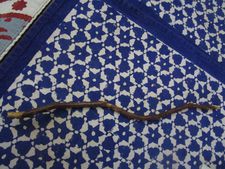 |
| Nibbled-on twig by the rescued bird from my grandmother's plum tree Photo: Anne-Katrin Titze |
VL: It’s sort of an anticipatory nostalgia. You already have the sense of loss of something that hasn’t been lost yet. It’s interesting to see how many people don’t have this.
AKT: They are all off-screen in your film, though.
VL: Right! It’ll be interesting to see if anyone in the audience doesn’t feel this way. Doing the Radiolab show, I was in the midst of production and I started getting feedback from people who had heard the segment on Rick’s egg. It came out to a 70/30% split. 30% being people who kept things with meaning, and 70% who said this is bad, this is hoarding, there’s no meaning in things, your memories are not in things, you’re delusional, this is magical thinking. It’s interesting to see how polarized it is. But even the most anti-material people seem to have at least one thing that’s important to them.
AKT: Speaking in code, the things that are most precious to us, we know how vulnerable they are. Rick says in the film that somebody said to him “I hope it’s not a family heirloom, haha.” That is so hurtful! Do you think age has something to do with it? As you may have seen, I lecture on fairy tales, and inanimate objects play such an important role in them. I don’t know if the fact that oral storytelling is disappearing has something to do with that. With the omnipresence of the Internet, our relationship to objects has changed, no?
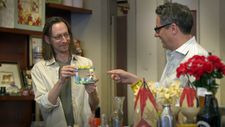 |
| Rob Walker and Josh Glenn rummage at a thrift store, in search of items for their Significant Objects Project Photo: Vincent Liota |
VL: It’s interesting. Heidi mentions that now she’s just rummaging online. The point you’re making about the preciousness - it’s very idiosyncratic what makes it valuable. That was one of the criteria for the objects we look at in the film. You’ve got things that are collectible. Everybody values grandpa’s war medals or bowling trophies or Willie Mays’s signed baseball. But it’s the things that came to us accidentally, that have no intrinsic value. Or Robert who grabs the grass to hold on to the time and have this thing. The odder the things are, we noticed, the better the story behind them. They always have a story. You see this weird thing, the sugar egg, which wasn’t even decorated - it has a great story behind it. As you mentioned fairy tales, it’s almost a parable. There’s the egg, the tree and the box with Rick, that’s really his story from the beginning. Once upon a time, he had this egg … And then there was this tree and what it meant to him. Then the tree gets cut down and it’s tragic. By making a box out of it, he gets to keep the tree and then gets to forward the story. It’s almost like the storybook closing at the end of the fable.
AKT: Humanity oozes out of every corner of your film. It’s so filled with goodwill. I love when Rick explains that the object is “proof that I was invited to a birthday party.” We all need that. Decades can go by but the proof that you were invited to a birthday party is worth something in this life. It’s very important.
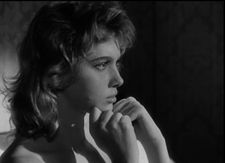 |
| Isabelle Corey in Jean-Pierre Melville’s Bob Le Flambeur: “She is this person on the verge of slipping into obscurity and Heidi finds her sweater …" |
VL: And that idea of time. Some people feel that time past is gone for ever and other people want to visit it. And I think that’s completely reasonable.
AKT: There are links to other films in DOC NYC. Two hours ago I spoke with Alessandro Rossellini, who has the film about his family, The Rossellinis, in the festival. I mentioned your film to him. He was driving in Rome. He has a moment where his uncle, Robin Rossellini, gives him a Swedish flag and I asked him what happened to that flag. He still has it on his terrace in Rome. Objects carry in them our relationships.
VL: Yeah, our identities, our personalities, our pasts and they keep people whole in some ways. But I’m always interested in the negative reactions people have to that. That amazes me. I hope this will counterbalance all the Marie Kondo-type shows. Or the Antiques Roadshow - I have this thing, it belonged to my grandfather, but I want it to be worth a lot of money! As if that’s going to make it really worth something.
AKT: The opposite makes sense to me - it’s mine, It has another kind of value, who cares if it’s worth money. Another Rossellini connection is that Isabelle Corey was also in a film by Roberto Rossellini.
VL: Which film?
AKT: Vanina Vanini [from 1961]. Another link to a film in DOC NYC is Rosebud. In Dean Martin: King of Cool, the filmmaker Tom Donahue, asks his subjects who knew Dean Martin what they think was his Rosebud. His daughter Deana gives an answer in the end. It has to do with a recipe for Pasta e Fagioli and a special ingredient.
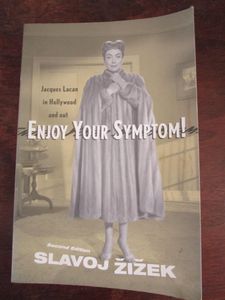 |
| Vincent Liota on keeping things: “I think you have to enjoy your symptom, I suppose.” Photo: Anne-Katrin Titze |
VL: That’s wonderful, I must see that. It’s interesting, that was a larger part of the film that got cut out because it was a bit of a cul-de-sac. I also do some film criticism and it’s usually things that are hiding in plain sight. One of them is Rosebud. So what’s the pivotal object in Citizen Kane? It’s not Rosebud. And actually it’s like having the Madeleine cookie. At the beginning of the movie he dies and releases the snow globe and it breaks. At the end of the movie, the last time we see him alive, he’s going on his rampage through his wife’s things and smashes things up.
He comes to her snow globe, that’s the second time we see it we think, and that’s when he says Rosebud. That suddenly changes everything and he walks away in that famous shot with the snow globe. And soon we presume he dies. Looking at the film again, I noticed that in this meet-cute-scene where he meets his wife-to-be, he gets splashed by a horse-drawn carriage going through a puddle and she invites him over to iron his clothes and to dry them. She’s talking to him and in the background is the snow globe. It was her snow globe, so it’s interesting because that triggers his memory of Rosebud.
AKT: It’s the doubling! It’s never just one thing. Most meaningful objects are meaningful for multiple reasons. Tell me about the Significant Objects project! In a way they are also manufacturing meaningful objects.
VL: Yes, I have a big debt of gratitude towards Josh [Glenn] and Rob [Walker], the guys who did that. Josh had written a book where he got people to write about objects that were important to them. That’s where I found Rick. Rick had written about his egg in that. This project was about: Let’s go buy things that have no value and find a great storyteller to attach a story to it. They cold-called and wrote to great writers like Colson Whitehead, Jonathan Lethem, William Gibson. Actually Heidi was one of the authors they wrote to. They loved it because I guess a writer loves a prop. And they donated the proceeds. The story then added value to the object. It was a tongue-in-cheek experiment. They’ll often refer to it as - they used the scientific method of a carefully controlled situation - but it was really a piece of performance art, I think. It did prove a point. It’s interesting, the people who relate to that part of the film the most, don’t relate to objects that don’t have intrinsic value.
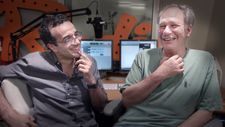 |
| Robert Krulwich at work with his Radiolab co-host Jad Abumrad Photo: Jason Longo |
AKT: I had to have a prop here for you. It’s a branch from my grandmother’s plum tree. I manufactured a second meaning, by using it as a perch in the birdcage for one of the birds I rescued. You can see the nibbled off bark here. By now, both my grandmother and the bird are dead.
VL: But you have the branch! Even though you manufactured it, it’s very much that bird nibbling that branch. Where do you keep that, on a mantle?
AKT: No, it was actually still stuck in the bird cage. I pulled it out for you. What’s your object? What’s your Rosebud?
VL: I have a ticket - that is along the lines of Heidi in that her desk is her diary - that I found going through my things and I realized that was the last movie that I went with to with my father before he died. I didn’t save it for that reason, but then I did.
AKT: What film was it?
VL: It was Star Wars, the first instalment of the second trilogy. That was ’99, ’98. I remembered it very clearly. As soon as I discovered it, it was valuable, as if I discovered a diamond or something. One thing I do that nobody else in the film does. Robert feels very strongly against this, I sort of do the zombie test. That Tufts philosopher [Daniel Dennett] who looks like Santa Claus? Robert talks about Einstein’s pencil in the film. You have a pencil and let’s say someone while you’re sleeping replaces it with another pencil, can you recognize that it’s a different pencil? If you can, then there is something intrinsic and it has its own personal history.
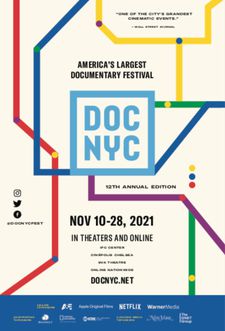 |
| DOC NYC 2021 poster |
My other thing is my father was a composer and classical musician and he always kept this mechanical pencil in his pocket and he would write music with it. After he died it sort of just disappeared and recently, within the last five years I realized what happened to that pen. I asked the relatives and nobody had kept it; it was very distinctive. Of course you have the Internet, which is the greatest thing, because I typed in everything I could remember about this mechanical pencil. Up it popped, the model number, when it was made; there was one on eBay and I bought it for $11. Sure, it wasn’t my father’s, but as soon as I touched that it brought back all these memories. I remembered what it felt like. That’s become a precious object, even though it’s a bit of an impostor. It’s almost like a bit of forensics, reconstructed.
AKT: Stand-in objects sometimes work their magic. We love impostors; even Cinderella was one. Thank you so much, I’ll keep my fingers crossed for a good premiere.
VL: I appreciate it so much!
Objects screens on Sunday, November 14 at 5:00pm - Cinépolis Chelsea - In-cinema Q&A with Vincent Liota, executive producer Sally Roy, subjects Robert Krulwich, Heidi Julavits, Rick Rawlins, Jad Abumrad, Josh Glenn, and Rob Walker will follow.
DOC NYC 2021 in cinemas (IFC Center - SVA Theatre - Cinépolis Chelsea) runs from November 10 through November 18 with select films screening online in the US from November 19 through November 28.








